Intel Announces Non-K 13th Gen Core For Desktop: New 65 W and 35 W Processors
by Gavin Bonshor on January 3, 2023 9:00 AM EST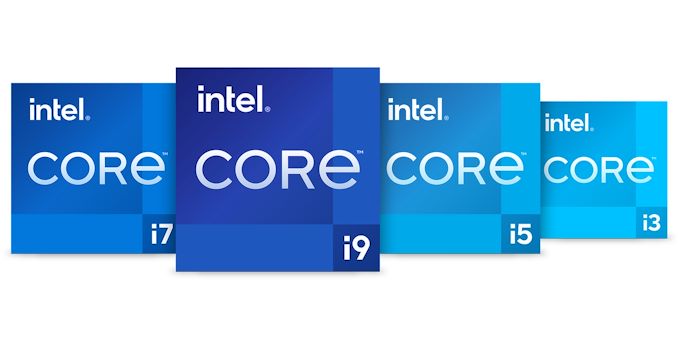
When Intel launches a new family of desktop processors, it typically unleashes its high-end unlocked SKUs first, such as the K and KF models. Not only does this give users a glimpse of its performance enhancements throughout its product development cycle and roadmap in the best possible light, but it also allows enthusiasts and high-end performance junkies to get their hands on the latest and most potent processors from the very beginning of the product cycle.
For the rest of the consumer market, Intel has finally pulled the proverbial trigger on its non-K series SKUs, with sixteen new Raptor Lake-S series processors for desktops. Varied across a mixture of bare multiplier locked SKUs such as the Core i9-13900 and Core i7-13700 with a TDP of 65 W, Intel has also announced its T series models with a TDP of just 35 W for lower powered computing, including the Core i9-13900T. Furthermore, Intel has launched its Core i3 series family, offering decent performance levels, albeit with just performance (P) cores and no efficiency (E) cores, at a more affordable price starting from $109.
Intel 13th Gen Core Non-K Series CPUs: 16 New CPUs, 65 W & 35 W
Although the overclockable parts typically get consumers' attention when they launch, most of Intel's sales come through its regular non-K parts. Despite not being world record holders regarding performance or overclocking ability, the non-K series SKUs account for most system builders and OEM systems across the entry-level and mid-range offerings.
Intel's non-K launch offerings as part of its Raptor Lake-S architecture all come with a TDP of 65 W or lower, with variants representing the Core i9, Core i7, and Core i5; Intel has also now pulled the trigger on its 13th Gen Core i3 series. Intel has sixteen new desktop processors with varying performance, specification, and price levels, ranging from 24-core (8P+16E) to quad-core (4P+0E) options. Memory support on the Core i9 and Core i7 series includes both DDR5-5600 and DDR4-3200, while the new Core i5 and Core i3 series support DDR5-4800 and DDR4-3200 as per JEDEC specifications.
| Intel 13th Gen Core i9 Series (Raptor Lake-S) | ||||||||||
| AnandTech | Cores P+E/T |
P-Core Base |
P-Core Turbo |
E-Core Base |
E-Core Turbo |
L3 Cache (MB) |
IGP | Base W |
Turbo W |
Price ($) |
| i9-13900K | 8+16/32 | 3300 | 5800 | 2200 | 4300 | 36 | 770 | 125 | 253 | $589 |
| i9-13900KF | 8+16/32 | 3300 | 5800 | 2200 | 4300 | 36 | - | 125 | 253 | $564 |
| i9-13900 | 8+16/32 | 2000 | 5600 | 1500 | 4200 | 36 | 770 | 65 | 219 | $549 |
| i9-13900F | 8+16/32 | 2000 | 5600 | 1500 | 4200 | 36 | - | 65 | 219 | $524 |
| i9-13900T | 8+16/32 | 1100 | 5300 | 800 | 3900 | 36 | 770 | 35 | 106 | $549 |
There are three new Intel 13th Gen Core i9 series processors to select from, starting at $549 with the Core i9-13900. All Core i9 series non-K parts include 8P+16E cores for 32 threads, and 36 MB of Intel Smart L3 cache, with the Core i9-13900 ($549) and Core i9-13900F ($524) sharing the same 5.6 GHz turbo clock speed and a base frequency of 3.3 GHz on the performance (P) cores. Both models also include a base TDP of 65 W and a turbo TDP of 219 W, which is plenty of power budget for turbo clock speeds on both the P and E cores. The only caveat is that the Core i9-13900F doesn't include Intel's UHD 770 integrated graphics (32 EUs); consequently, it has a $25 lower MSRP.
The third of Intel's Core i9 non-K series chips is the Core i9-13900T, with the T signifying that it's a 35 W part. A lower power envelope means it sacrifices plenty of MHz to account for the drop in power. The Core i9-13900 has a P-core base frequency of 1.1 GHz, with a turbo clock speed of up to 5.3 GHz; the E-core specifications are similar, with a base frequency of 800 MHz and a turbo of 3.9 GHz. Even though the Core i9-13900T ($549) comes with a 35 W base TDP, it has a turbo TDP of 106 W.
| Intel 13th Gen Core i7 Series (Raptor Lake-S) | ||||||||||
| AnandTech | Cores P+E/T |
P-Core Base |
P-Core Turbo |
E-Core Base |
E-Core Turbo |
L3 Cache (MB) |
IGP | Base W |
Turbo W |
Price ($) |
| i7-13700K | 8+8/24 | 3400 | 5400 | 2500 | 4200 | 30 | 770 | 125 | 253 | $409 |
| i7-13700KF | 8+8/24 | 3400 | 5400 | 2500 | 4200 | 30 | - | 125 | 253 | $384 |
| i7-13700 | 8+8/24 | 2100 | 5200 | 1500 | 4100 | 30 | 770 | 65 | 219 | $384 |
| i7-13700F | 8+8/24 | 2100 | 5200 | 1500 | 4100 | 30 | - | 65 | 219 | $359 |
| i7-13700T | 8+8/24 | 1400 | 4900 | 1000 | 3600 | 30 | 770 | 35 | 106 | $384 |
Moving onto the Core i5 family, Intel has three new Raptor Lake-S desktop processors, including two 65 W and one T series (35 W) part. All three include 30 MB of Intel The Core i7-13700 and Core i7-13700F both feature a P-core turbo clock speed of 5.2 GHz, while the restrictions in power mean that the P-core base frequency sits at just 2.1 GHz. For the efficiency (E) cores, this means that they have a base frequency of 1.5 GHz and a turbo clock speed of 4.1 GHz, while both conform to Intel's interpretation of 65 W; they both have a turbo TDP of 219 W.
The Core i7-13700T, as per the specifications, has a base TDP of 35 W, but it has a turbo TDP of 106 W. As with other T-series family products, the lower TDP puts constraints on raw frequency, with a P-core base frequency of just 1.4 GHz, but the eight performance cores boost to 4.9 GHz, while the eight efficiency cores turbo up to 3.6 GHz. It shares the same level of 30 MB of L3 cache as the other Raptor Lake-S desktop Core i7 processors and includes Intel's UHD 770 integrated graphics chip.
| Intel 13th Gen Core i5/i3 (Raptor Lake-S) | ||||||||||
| AnandTech | Cores P+E/T |
P-Core Base |
P-Core Turbo |
E-Core Base |
E-Core Turbo |
L3 Cache (MB) |
IGP | Base W |
Turbo W |
Price ($) |
| i5-13600K | 6+8/20 | 3500 | 5100 | 2600 | 3900 | 24 | 770 | 125 | 181 | $319 |
| i5-13600KF | 6+8/20 | 3500 | 5100 | 2600 | 3900 | 24 | - | 125 | 181 | $294 |
| i5-13600 | 6+8/20 | 2700 | 5000 | 2000 | 3700 | 24 | 770 | 65 | 154 | $255 |
| i5-13600T | 6+8/20 | 1800 | 4800 | 1300 | 3400 | 24 | 770 | 35 | 92 | $255 |
| i5-13500 | 6+8/20 | 2500 | 4800 | 1800 | 3500 | 24 | 770 | 65 | 154 | $232 |
| i5-13500T | 6+8/20 | 1600 | 4600 | 1200 | 3200 | 24 | 770 | 35 | 92 | $232 |
| i5-13400 | 6+4/16 | 2500 | 4600 | 1800 | 3300 | 20 | 730 | 65 | 148 | $221 |
| i5-13400F | 6+4/16 | 2500 | 4600 | 1800 | 3300 | 20 | - | 65 | 148 | $196 |
| i5-13400T | 6+4/16 | 1300 | 4400 | 1000 | 3000 | 20 | 730 | 35 | 82 | $221 |
| i3-13100 | 4+0/8 | 3400 | 4500 | - | - | 12 | 730 | 60 | 89 | $134 |
| i3-13100F | 4+0/8 | 3400 | 4500 | - | - | 12 | - | 58 | 89 | $109 |
| i3-13100T | 4+0/8 | 2500 | 4200 | - | - | 12 | 730 | 35 | 69 | $134 |
Intel's Core i5 family has grown the most from today's non-K Raptor Lake-S series announcement with seven new SKUs. Similar to how it identified its Alder Lake (12th Gen) Core i5 family, it has two distinguishing configurations between the two halves of its range; the top tier Core i5 series with 6P+8E (14) and lower tier chips with 6P+4E (10) cores. There's also a trifecta of T-series chips, each with a base TDP of 35 W; the Core i3-13600T, Core i5-13500T, and Core i3-13400T.
At the top of the series are the Core i5-13600 ($255) and Core i5-13500 ($232) chips, both with UHD 770 integrated graphics, 6P+8E cores, and twenty threads. Both include a base TDP of 65 W, while the turbo TDP rating sits at 154 W. The only difference between both chips is through core frequency, with the Core i5-13500 having a P-core frequency of 2.7 GHz and a turbo frequency of 4.8 GHz; the i5-13600 has a 2.5 GHz base frequency and the same 4.8 GHz turbo frequency.
Representing the unusual lower echelon Core i5 series is the Core i5-13400, along with the Core i5-13400F with no integrated GPU and the Core i5-13400T with a base TDP of 35 W and a turbo TDP of just 82 W. Aside from a lower core count compared to the rest of the RPL Core i5 family, so is the L3 cache which has been cut down to 20 MB. As a consequence, so has the price, as the Core i5-13400 has an MSRP of $221, while the Core i5-13400F without graphics costs $196.
Intel Core i3 13th Gen Series: No Efficiency Cores, Starting from $109
One of the major announcements from Intel's wave of 13th Gen Core series launches is the introduction of its entry-level Core i3 series. Intel has readied three Core i3 series chips to the market, including the Core i3-13100, the Core i3-13100F, and the Core i3-13100T. One of the cutbacks from the rest of the Raptor Lake-S family is that the integrated graphics have been traded down to the UHD 730 instead of the UHD 770.
The Core i3-13100 has four performance (P) cores and no efficiency cores, meaning the Core i3 is still a quad-core CPU with a maximum capacity of eight threads. It has a base frequency of 3.4 GHz and a core frequency of 4.5 GHz, along with just 12 MB of L3 cache. The base TDP is 60 W, while the turbo TDP is 89 W. On the flip side, the Core i3-13100F has the same core frequencies, both at base and turbo, but with a slightly lower 58 W TDP and the same 89 W turbo TDP, just without integrated graphics.
At the bottom (in terms of performance) of the Core i3 family is the Core i3-13100T, which has a base core frequency of 2.5 GHz and a turbo frequency of 4.2 GHz. It has the same 12 MB of L3 cache as the other Core i3 chips, but it has UHD 730 integrated graphics (16 EUs) with a base TDP of 35 W and a turbo TDP of just 69 W, perfect for low-powered small form factor systems.
Regarding platform support, all of Intel's 13th Gen Core series processors are compatible with the latest 700-series chipsets and backward compatible with the 600-series chipsets such as Z690, B660, and H610. We expect to start seeing Intel's new 13th Gen Core chips in OEM systems imminently, however the timeframe for sales of the individual chips hasn't been disclosed. Still, we expect it will be sooner than later.


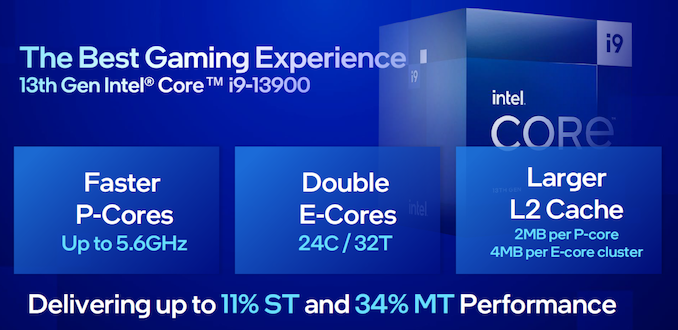
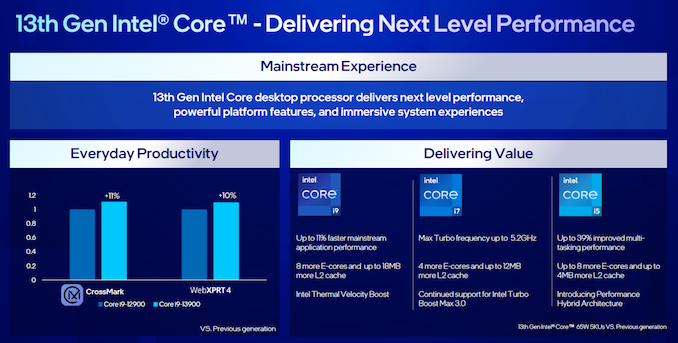
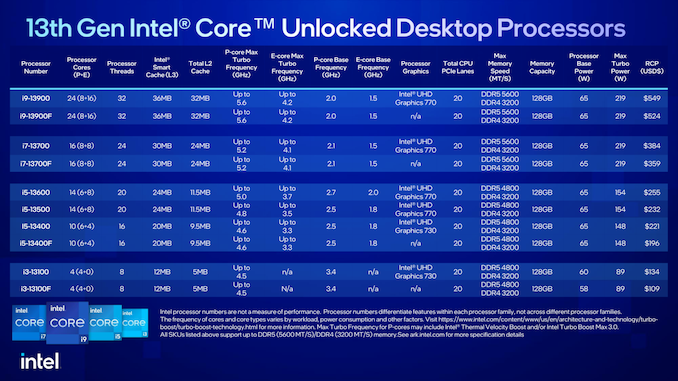
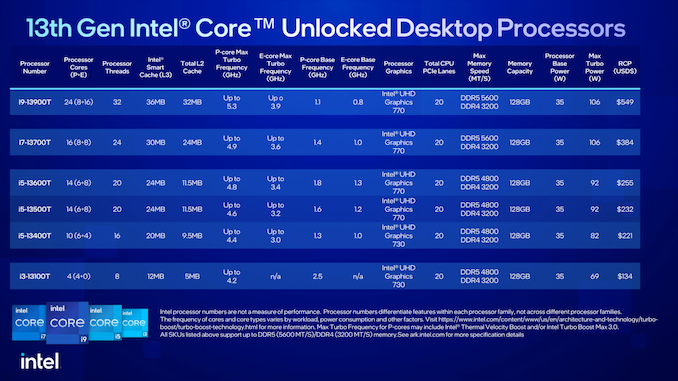














28 Comments
View All Comments
Dolda2000 - Tuesday, January 3, 2023 - link
I find it interesting to compare the 12900 and 13700, since they're the same 8P8E and 65W configuration. I'm a bit surprised by how much lower the base frequencies are on the 13700. I understand, of course, that the 13700 technically is a lower tier in the total stack than the 12900 was, but still. Raptor Lake was supposed to have significantly better efficiency than Alder Lake, wasn't it? Makes me a bit worried about the laptop chips.KaarlisK - Tuesday, January 3, 2023 - link
Some i3 have the wrong GPUs statedRyan Smith - Wednesday, January 4, 2023 - link
All of the i3 parts with an iGPU have a UHD 730 (24 EU) configuration. I'm not seeing an error here.ballsystemlord - Wednesday, January 4, 2023 - link
I'm guessing the i3 parts have no E-cores because Intel doesn't want people to think that their gaming performance in the i3 lineup is horrible.James5mith - Thursday, January 5, 2023 - link
I personally love the idea of extremely low base clocks. Having a CPU that can run at 800MHz when it isn't needed, and ~5GHz when it is under full load is great for overall power efficiency.What I mostly dislike about this generation seems to be the no good mid-range non-E core solutions.
If I go with an Intel upgrade for my living room gaming PC, it's probably going to be an i5-12600. That's the best solution for a good mix of performance/TDP that I can see in Intel's last 2 generations.
The i5-13600 including e-cores seems like a regression to me.
chane - Tuesday, January 10, 2023 - link
Trouble now is except for maybe >$450. ASUS models, so far there's no DDR5 ECC RAM supporting W680 boards. We can probably blame that on Intel for delaying launch of those 65 watt Raptor SKUs to thwart AMD's marketing moves.viking99 - Sunday, January 15, 2023 - link
I believe that there are some typos : "The only difference between both chips is through core frequency, with the Core i5-13500 having a P-core frequency of 2.7 GHz and a turbo frequency of 4.8 GHz; the i5-13600 has a 2.5 GHz base frequency and the same 4.8 GHz turbo frequency."Shouldn't it be (for P-core):
i5-13500 base = 2.5 GHz & Turbo = 4.8 GHz
i5-13600 base = 2.7 GHz & Turbo =5.0 GHz
viking99 - Sunday, January 15, 2023 - link
If I power limit the i5-13600K to 65W, how does the performance compare to the i5-13600 (also at 65W)? I have not been able to find any test of this [yet]?I prefer the i5-13600K at 65W if the performance is as good (or better) because I can always increase the performance (and power consumption) later if needed.